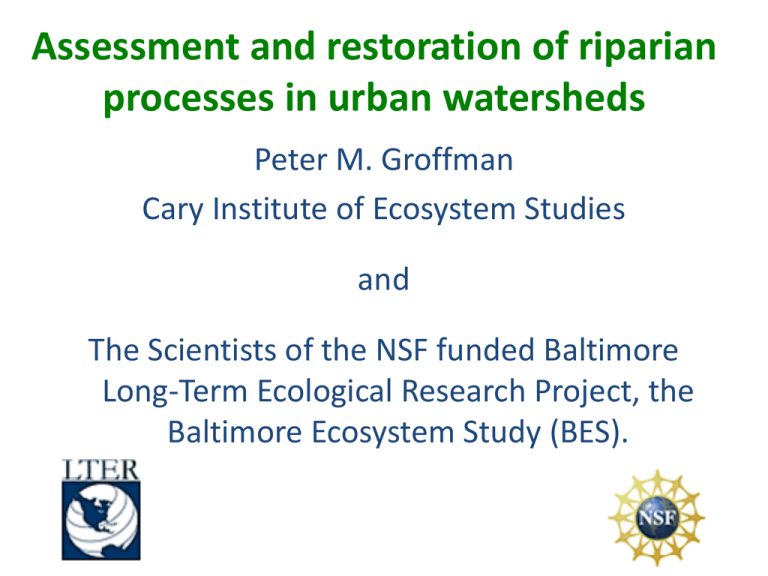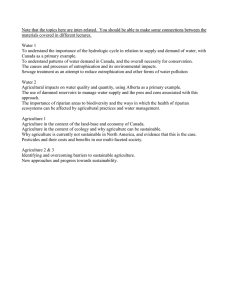Assessment and restoration of riparian processes in urban watersheds
advertisement

Assessment and restoration of riparian processes in urban watersheds Peter M. Groffman Cary Institute of Ecosystem Studies and The Scientists of the NSF funded Baltimore Long-Term Ecological Research Project, the Baltimore Ecosystem Study (BES). Outline: • Urbanization effects on riparian zones. • Are detention basins the new riparian zone? • Does stream and riparian restoration have a nitrogen benefit. • Evaluating riparian zones at the watershed scale. RIPARIAN ZONES: • Critical interface between terrestrial and aquatic components of a watershed. • Demonstrated ability to prevent pollutant movement from upland land uses into streams. • Most work on groundwater nitrate, in agricultural watersheds. • Urban stream syndrome: Natural Channel Water Table Stream Channel with Incision Due to Increased Runoff – High storm flows. – Incised channels. – Drier riparian zones with lower water tables. •Channel Erosion •Nonfunctional Floodplain •Dry Riparian Soils Urban stream syndrome: Urban stream syndrome results in drier soils and lower water table in riparian zone: 0 Jan-00 Jan-02 Jan-04 Water table depth (mm) -200 -400 -600 -800 -1000 Suburban (Gwynnbrook) -1200 Forested (Pond Branch) Jan-06 Jan-08 Jan-10 Jan-12 Urban stream syndrome results in higher groundwater nitrate in riparian zone: Nitrate (mg N/L) 2.4 1.6 0.8 0 Urban (Cahill) Suburban (Glyndon) Suburban (Gwynnbrook) Forested (Pond Branch) Denitrification NO3- NO2- NO N2O N2 - Anaerobic - Heterotrophic (requires organic C) • Expect high rates in wetland soils. • Key component of the water quality maintenance function of riparian zones. Nitrification NH4+ NO2- NO3- Aerobic - Substrate driven (need high NH4+) • Important internal source of nitrate in an ecosystem. • Symptom of N richness or N saturation. Nitrate (mg N kg-1) 0 2 4 6 8 10 0 10 20 Depth 30 40 50 60 70 80 90 Source: Groffman et al. (2002) Urban Forested reference Suburban (downstream) Suburban (headwaters) Nitrification (mg N kg-1 d-1) -0.2 0 0.2 0.4 0 10 20 Depth 30 40 50 60 70 80 90 Source: Groffman et al. (2002) 0.6 0.8 1 1.2 1.4 Are detention basins the new riparian zone? • Stormwater structures (detention basins) are engineered to mitigate impact of impervious surfaces on stream discharge. • Their impact on nutrients (especially nitrogen) in unclear. Can you find the detention basins in this suburban landscape? ½ mile x ¾ mile area Source: Neil Bettez Can you find the detention basins in this suburban landscape? ½ mile x ¾ mile area Source: Neil Bettez Storm water Management Structures in the Gwynns Falls Type Structure Type (TN removal efficiency) Count Percent of total Percent of Drainage Area Area weighted removal A Wet Ponds and Wetlands (30%) 23 3% 1 0.33 Type of Structure shallow marsh Retention Pond Bay Separator B Dry Detention & Hydrodynamic structure (5%) Oil & Grit Separator 275 33% 10 0.48 Still Basin Underground storage Detention Pond C Dry Extended Detention (30%) 272 33% 8 2.39 Dry Ext Detention Pond Ext Det Pond Porous Pavement D Infiltration Practices (50%) 90 11% 0.34 0.14 Swale Infiltration Trench Infiltration basin Dry Well E Filtering Practices (40%) 167 20% 1.79 0.72 BIO-Retention Sand filter Total 827 100% 21% (?) 4.06% (Stormwater workgroup: BMP Pollutant Removal Efficiencies.PDF ) Denitrification potential higher in detention basins than in natural riparian zones: Denitrification Potential (mg N kg-1 hr-1) 2.5 2.0 1.5 1.0 0.5 0.0 A B C D E SM DP EDSD IB SF Bettez and Groffman (2012) Herb Fors Riparian Is there a nitrogen benefit to stream and riparian restoration? Restored Urban Stream: Early Stage Restored Urban Stream: Developed Stage Stable, unconnected floodplain “ConnectedFloodplain Push Pull Soil Surface Water Table Push-Pull Method 1. Pump ground water 2. Amend with 15NO3- ,Br-, SF6 3. Lower DO to ambient levels. 4. Push into mini-piezometer 5. Incubate for 4 hours 6. Pull from mini-piezometer Plume Addy et al. (2002) Denitrification Rate (μg/N/kg soil/day) Denitrification higher in restored, connected riparian zones: 300 250 200 Unrestored High Bank Unrestored Low Bank Restored High Un-connected Bank Restored Low Connected Bank 150 100 50 0 June 2003 Kaushal et al. (2008) November 2003 June 2004 Nitrate concentrations lower in restored hyporheic zones: Nitrate Concentration (mg/L) Hyporheic Ground Water 2 1.6 1.2 0.8 0.4 0 June November Site Kaushal et al. (2008) Unrestored Restored Mass Removal of Nitrate-N (μg/L) Nitrate dynamics improved in restored hyporheic zones: Unrestored (Coinciding Measurements) Restored (Scenario) 8000 6000 R2 = 0.87 4000 R2 = 0.70 2000 0 0 2 4 6 8 10 -2000 Groundwater Residence Time (Days) Kaushal et al. (2008) Can stream restoration create denitrification “hotspots” on the floodplain? • Floodplain wetlands can be created deliberately or incidentally during stream restoration projects. • These wetlands have the potential to serve as floodplain NO3- sinks if: • They process a significant amount of water. • With significant residence time. • With high denitrification. • With high plant (algae, macrophyte) uptake. Minebank Run oxbow wetlands: Oxbow 1, Seepage flow wetland • Created incidentally during stream restoration. • Vary in nature and extent of connectivity to the stream. • Measurements of hydrology, denitrification, 15N uptake by plants and algae, storm dynamics. Harrison et al. (2011, 2012a,b, 2014) Oxbow 2, Surface flow wetland Can we assess riparian condition at the watershed scale: Rte 165 N 30m buffer T1 Right bank T2 T3 • Ground-truth map: 34 drainage classes • Does SSURGO reflect this complexity? PD VPD VPD Stream flow PD Rte 165 SPD SPD MWD Left bank Source: Rosenblatt et al. (2001) Original Scale of GIS Data Base Can Alter Inputs & Outputs to Watershed Models 5% Proportion of stream length bordered by hydric soils Source: Rosenblatt et al. (2001) 75% Scale/type of spatial data can mask or display pathways and sinks (data: Kingston Quad-RI) Streams (1:24,000) Ponds (1:24,000) Forest / Open Space Agriculture Residential (low density) Residential (med density) Res. (med high density) Institutional Gravel pits Source: Groffman et al. (2009) National Wetland Inventory (1:24,000) displays potential sinks Streams (1:24,000) Ponds (1:24,000) Forest / Open Space Agriculture Residential (low density) Residential (med density) Res. (med high density) Institutional Gravel pits NWI Wetlands (1:24K) Source: Groffman et al. (2009) SSURGO Hydric Soils suggest wetlands and zero order streams connect source to stream Streams (1:24,000) Ponds (1:24,000) Forest / Open Space Agriculture Residential (low density) Residential (med density) Res. (med high density) Institutional Gravel pits NWI Wetlands Source: Groffman et al. (2009) Hydric Soils (SSURGO) (1:15,840) High resolution stream data and hydric soils display an active biogeochemical landscape Streams (1:5,000) Ponds (1:5,000) Forest / Open Space Agriculture Residential (low density) Residential (med density) Res. (med high density) Institutional Gravel pits NWI Wetlands Source: Groffman et al. (2009) Hydric Soils (SSURGO) (1:15,840) Detecting riparian and stream condition with LiDAR: Source: Andy Miller Key issues going forward: • Urbanization disrupts riparian processing, converting riparian zones from sinks to sources of nitrogen. • Stormwater control measures may restore the “lost” riparian effect. • Stream and riparian restoration, especially those that “reconnect” streams and riparian zones should have a nitrogen benefit. • Riparian evaluations at the watershed scale: – New tools such as SSSURGO and LiDAR. – Need monitoring at the watershed scale. • Surface water has higher NH4+ (mg/L) nitrate concentrations than groundwater and streamwater – suggests oxbows are “sinks” for nitrate. A NO3- (mg/L) Minebank Run oxbow wetlands: • Surface water has lower PO4- (μg/L) phosphate concentrations than groundwater or streamwater, suggests oxbows are “sources” of Harrison et al. (2012) phosphate. GW WC SSW GW WC SSW GW WC SSW B C Denitrification in urban floodplain wetlands: • Measured in-situ denitrification summer and winter 2008 using the 15N-push pull method. • Analyzed gas samples for N2O and N2 Constructed storm water wetlands Oxbow “relict” wetlands Denitrification in urban floodplain wetlands: • Denitrification rates were high – a significant sink for nitrate. • Rates were higher in winter than in summer. • Denitrification similar across all wetland types. Harrison et al. (2011) Oxbow “Relict” Constructed Reference N2O yield during denitrification in urban floodplain wetlands: Oxbow “Relict” Constructed Reference A • N2 was the dominant end-product at all sites. • N2O yield (N2O:N2 ratio) was low at all sites. Harrison et al. (2011) B 15N mass-balance approach in oxbow “relict” wetlands: • Determine the fate of 15N added to wetlands: • Algae • Macrophyes • Sediments • Denitrification (unaccounted for N) • Two additions: • Mid growing season • Very early (almost dormant) growing season 15N mass-balance approach in oxbow “relict” wetlands: Methods • Water column samples, algae, macrophytes, and sediment were collected before and after the six-day experiment to determine 15N natural abundance. • 15N-KNO 3 and Br- solution added summer 2009 and spring 2010. • Water samples were collected six consecutive days in six discrete locations (inlet to outlet) in each oxbow. 15N 200 • Complete mixing of 15N Bromide 160 14 12 µg/L 10 120 8 15N 80 6 • All added 15N was 4 40 2 0 processed by day 3. 0 0 1 2 3 Days since 15N additions 20 Oxbow 2 Bromide 15 7 6 5 10 4 15N µg/L 8 15N 3 5 2 1 0 0 0 1 Days since 2 15N 3 additions Harrison et al. Bromide (mg/L) added 15N by day 2. Oxbow 1 Bromide (mg/L) mass-balance approach in oxbow “relict” wetlands: Results 15N mass-balance approach in oxbow “relict” wetlands: Fate of 15N 23 57 19 97 13 38 39 24 87





